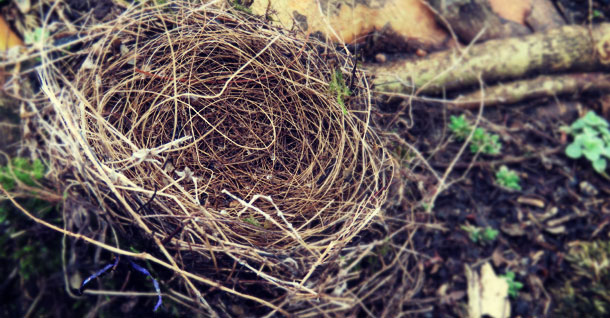
Photo by Jill Crainshaw.
I rescued an empty nest the other day. In the rain. I don’t know why I rescued the nest. No bird lives in it. It was last year’s nest.
I was in my car, pulling out of the driveway to head somewhere, when I saw the nest in the middle of the road in front of my house. Instead of driving by or driving over it, I stopped the car, stepped out into the springtime deluge, and hurried over to it, looking up and down the street for other cars (and for the eyes of curious neighbors) as I went.
The nest was beautiful, perfect in its construction, with a singular strand of sapphire yarn woven into its middle. I picked it up. It was fragile and soggy. And since I was now dripping from the rain and late for where I was headed, I laid the nest at the base of a tree in the sidewalk buffer and dashed back to my car.
Sometimes I think I spend far too much time rescuing last year’s nests. Perhaps we all do. How do we decide, after all, how much energy to give to preserving last year’s architectural delights, and how much to use building for this year and the future?
There is something to be said, I think, for the intricate magnificence of some of last year’s nests. Those nests held and hold precious, life-shaping memories. They nurtured possibilities and provided launching pads for nestlings’ first flights.
The nest reminded me of how, in Christian traditions, we are discovering again the ways in which early believers became community and worshiped together. Some of these discoveries serve as powerful evidence of the grace-filled power of God’s gospel.
But we still have work to do. Last year’s nests were not always hospitable places. Much about the Gospel’s justice-making still eludes us as we hold on with too much caution and fear to nests that are emptying if not already abandoned.
I photographed my rescued nest. The next day I decided to take a few more photos of it. But the nest was no longer where I had left it. Perhaps another critter took it. Then I spotted the nest about halfway up the sidewalk toward my house. Perhaps the wind had blown it there.
The next day the nest was even closer to the house. I noticed that it was smaller, too.
That’s when I realized that this year’s birds were using bits and pieces of last year’s nest to build for this spring season.
Verses from an ancient text, Ezekiel 17, came to mind as I reflected on last year’s nest: “Under that tree every kind of bird will live; in the shade of its branches will nest winged creatures of every kind.”
I like the idea of a tree full of every kind of nest.
Doesn’t God invite all of us to nest in God’s tree? Isn’t this invitation the way God sustains the earth and communities of faith?
And if that’s true, then might not a more expansive and generous nest design be in order?
And might it not also be true that a bit of sapphire yarn, and a few choice twigs from last year’s nest, are just what are needed to remind present and future nestlings of the gifts and challenges of the past, and to make the nests we are now building places we can call home?
 About Jill Crainshaw
About Jill Crainshaw
Jill Crainshaw is a PCUSA minister and Blackburn Professor of Worship and Liturgical Theology at Wake Forest University School of Divinity.
Leave a Reply